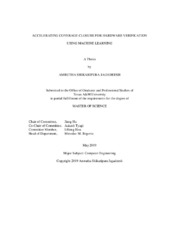| dc.contributor.advisor | Hu, Jiang | |
| dc.contributor.advisor | Tyagi, Aakash | |
| dc.creator | Jagadeesh, Amrutha Shikaripura | |
| dc.date.accessioned | 2020-03-10T19:19:55Z | |
| dc.date.available | 2020-03-10T19:19:55Z | |
| dc.date.created | 2019-05 | |
| dc.date.issued | 2019-04-05 | |
| dc.date.submitted | May 2019 | |
| dc.identifier.uri | https://hdl.handle.net/1969.1/187544 | |
| dc.description.abstract | Functional verification is used to confirm that the logic of a design meets its specification. The most commonly used method for verifying complex designs is simulation-based verification. The quality of simulation-based verification is based on the quality and diversity of the tests that are simulated. However, it is time consuming and compute intensive on account of the fact that a large volume of tests must be simulated to exhaustively exercise the design functionality in order to find and fix logic bugs.
A common measure of success of this exercise is in the form of a metric known as functional coverage. Coverage is typically indicated as a percentage of functionality covered by the test suite. This thesis proposes a novel methodology to construct a model using SVM, Gradient Boosting Classifier and Neural Networks aimed at replacing random test generation for speeding up coverage collection. | en |
| dc.format.mimetype | application/pdf | |
| dc.language.iso | en | |
| dc.subject | Functional Verification | en |
| dc.subject | Coverage | en |
| dc.subject | Random Test Generation. | en |
| dc.title | Accelerating Coverage Closure For Hardware Verification Using Machine Learning | en |
| dc.type | Thesis | en |
| thesis.degree.department | Electrical and Computer Engineering | en |
| thesis.degree.discipline | Computer Engineering | en |
| thesis.degree.grantor | Texas A&M University | en |
| thesis.degree.name | Master of Science | en |
| thesis.degree.level | Masters | en |
| dc.contributor.committeeMember | Hou, I-Hong | |
| dc.type.material | text | en |
| dc.date.updated | 2020-03-10T19:19:55Z | |
| local.etdauthor.orcid | 0000-0003-3465-9068 | |


